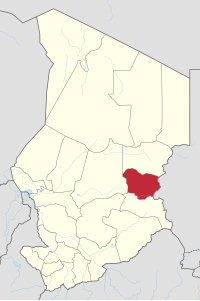Ouaddaï Region
13°49′48″N 20°49′58″E / 13.83°N 20.8328°E
Ouaddaï
وداي | |
|---|---|
 Map of Chad showing Ouaddaï. | |
| Country | Chad |
| Departments | 3 |
| Sub-prefectures | 16 |
| Regional capital | Abéché |
| Population (2009)[1] | |
| • Total | 721,166 |
Ouaddaï or Wadai (
Ouaddaï Prefecture; in 2008 the southern portions of Ouaddaï (the Sila Department and Djourf Al Ahmar Department) were split off to become the new Sila Region (also known as Dar Sila).[2]
History

The region was the heartland of the former
- are located in modern Ouaddaï region.Geography
The region borders
Batha Region to the west. The terrain is generally flat savannah, rising slightly towards the east where the Ouaddaï highlands
are located.
Settlements
Abéché is the capital of the region and is the fourth largest city in Chad; other major settlements include Abdi, Adré, Am Hitan, Bourtail, Chokoyan, Hadjer Hadid, Marfa, Mabrone and Tourane.[3]
Demography
As per the 2009 Chadian census, the region has a population of 721,166.Surbakhal.[4]
Subdivisions
Since 2008, the region of Ouaddaï is divided into three departments:
| Department | Capital | Sub-prefectures |
|---|---|---|
| Abdi | Abdi | Abdi, Abkar Djombo, Biyeré |
| Assoungha | Adré | Adré, Hadjer Hadid, Mabrone, Borota, Molou, Tourane |
| Ouara | Abéché | Abéché, Abougoudam, Chokoyan, Bourtaïl, Amleyouna, Gurry, Marfa |
References
- ^ a b DEUXIEME RECENSEMENT GENERAL DE LA POPULATION ET DE L’HABITAT: RESULTATS GLOBAUX DEFINITIFS (PDF) (Report). INSEED. March 2012. p. 24. Archived from the original (PDF) on 24 September 2015. Retrieved 10 March 2017.
- ^ "Ordonnance n° 002/PR/08 portant restructuration de certaines collectivités territoriales décentralisées" [Ordinance No. 002/PR/08 on restructuring of certain decentralized local authorities]. Government of Chad. 19 February 2008. Archived from the original on March 4, 2016.
- UNOCHA. Retrieved 27 September 2019.
- ^ "Languages of Chad". Ethnologue. Retrieved 27 September 2019.
